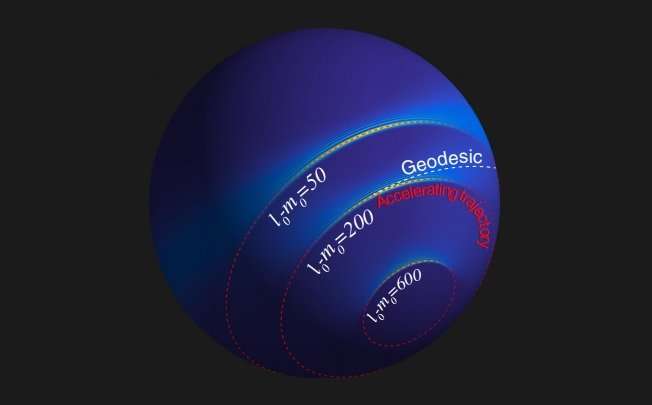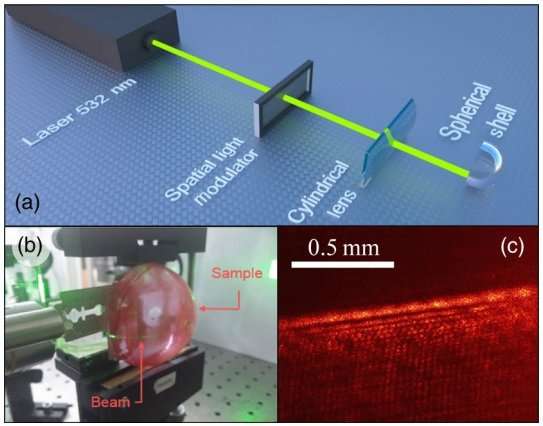January 12, 2018 feature
Accelerating light beams in curved space

By shining a laser along the inside shell of an incandescent light bulb, physicists have performed the first experimental demonstration of an accelerating light beam in curved space. Rather than moving along a geodesic trajectory (the shortest path on a curved surface), the accelerating beam bends away from the geodesic trajectory as a result of its acceleration.
Previously, accelerating light beams have been demonstrated on flat surfaces, on which their acceleration causes them to follow curved trajectories rather than straight lines. Extending accelerating beams to curved surfaces opens the doors to additional possibilities, such as emulating general relativity phenomena (for example, gravitational lensing) with optical devices in the lab.
The physicists, Anatoly Patsyk, Miguel A. Bandres, and Mordechai Segev at the Technion – Israel Institute of Technology, along with Rivka Bekenstein at Harvard University and the Harvard-Smithsonian Center for Astrophysics, have published a paper on the accelerating light beams in curved space in a recent issue of Physical Review X.
"This work opens the doors to a new avenue of study in the field of accelerating beams," Patsyk told Phys.org. "Thus far, accelerating beams were studied only in a medium with a flat geometry, such as flat free space or slab waveguides. In the current work, optical beams follow curved trajectories in a curved medium."
In their experiments, the researchers first transformed an ordinary laser beam into an accelerating one by reflecting the laser beam off of a spatial light modulator. As the scientists explain, this imprints a specific wavefront upon the beam. The resulting beam is both accelerating and shape-preserving, meaning it doesn't spread out as it propagates in a curved medium, like ordinary light beams would do. The accelerating light beam is then launched into the shell of an incandescent light bulb, which was painted to scatter light and make the propagation of the beam visible.
When moving along the inside of the light bulb, the accelerating beam follows a trajectory that deviates from the geodesic line. For comparison, the researchers also launched a nonaccelerating beam inside the light bulb shell, and observed that that beam follows the geodesic line. By measuring the difference between these two trajectories, the researchers could determine the acceleration of the accelerating beam.

Whereas the trajectory of an accelerating beam on a flat surface is determined entirely by the beam width, the new study shows that the trajectory of an accelerating beam on a spherical surface is determined by both the beam width and the curvature of the surface. As a result, an accelerating beam may change its trajectory, as well as periodically focus and defocus, due to the curvature.
The ability to accelerate light beams along curved surfaces has a variety of potential applications, one of which is emulating general relativity phenomena.
"Einstein's equations of general relativity determine, among other issues, the evolution of electromagnetic waves in curved space," Patsyk said. "It turns out that the evolution of electromagnetic waves in curved space according to Einstein's equations is equivalent to the propagation of electromagnetic waves in a material medium described by the electric and magnetic susceptibilities that are allowed to vary in space. This is the foundation of emulating numerous phenomena known from general relativity by the electromagnetic waves propagating in a material medium, giving rise to the emulating effects such as gravitational lensing and Einstein's rings, gravitational blue shift or red shift, which we have studied in the past, and much more."
The results could also offer a new technique for controlling nanoparticles in blood vessels, microchannels, and other curved settings. Accelerating plasmonic beams (which are made of plasma oscillations instead of light) could potentially be used to transfer power from one area to another on a curved surface. The researchers plan to further explore these possibilities and others in the future.
"We are now investigating the propagation of light within the thinnest curved membranes possible—soap bubbles of molecular thickness," Patsyk said. "We are also studying linear and nonlinear wave phenomena, where the laser beam affects the thickness of the membrane and in return the membrane affects the light beam propagating within it."
More information: Anatoly Patsyk et al. "Observation of Accelerating Wave Packets in Curved Space." Physical Review X. DOI: 10.1103/PhysRevX.8.011001
Journal information: Physical Review X
© 2018 Phys.org



















